- Italy Tours Home
- Italy Ethos
- Tours 2023
- Blog
- Contact Us
- Dolomites
- Top 10 Dolomites
- Veneto
- Dolomites Geology
- Dolomiti Bellunesi
- Cortina
- Cadore
- Belluno
- Cansiglio
- Carso
- Carnia
- Sauris
- Friuli
- Trentino
- Ethnographic Museums
- Monte Baldo
- South Tyrol
- Alta Pusteria
- Dobbiaco
- Emilia-Romagna
- Aosta Valley
- Cinque Terre
- Portofino
- Northern Apennines
- Southern Apennines
- Italian Botanical Gardens
- Padua Botanical Garden
- Orchids of Italy
Alpine Flora: an Extraordinary Story of
Beauty and Resilience.
Alpine
plants: what are they?
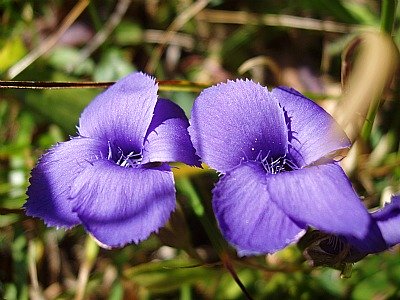
The Alpine Flora displays some of the most amazing plants on earth. But what is it that makes 'Alpines' so unique – in other words, what makes an ‘Alpine’ ... an ‘Alpine’?
The earliest definition of an Alpine plant was given in the Quarterly Bulletin of the British Alpine Garden Society as far back as 1937, and it stated that the term 'Alpine’ refers to “a manner of life, and to the taking of a form necessary to live that life” – but that in itself did not provide a simple definition, which remained debatable (and debated) ever since.
Strictly speaking, Alpine plants are found only above the tree line in mountainous regions of the world – and therefore not just in the Alps (even though these plants get their collective name from this mountain chain – one of the most important in the world and certainly the most famous in Europe).
So far, then, we have established that above the tree line is where the ‘proper’ Alpine zone is found, and therefore where ‘true’ Alpines are said to dwell.
Undoubtedly, there are some genera that we tend to identify as ‘quintessentially’ Alpine; amongst these, we certainly have to include (for the mountains of Europe) Primula, Gentiana, Androsace, Saxifraga (pictured below, see an image of a showy, classic “electric blue” trumpet of Gentiana kochiana, taken in the area of the Vette Feltrine, while above is a blue-lilac-flowering Gentian, Gentiana ciliata, portrayed in the magical uplands of the Tre Cime).
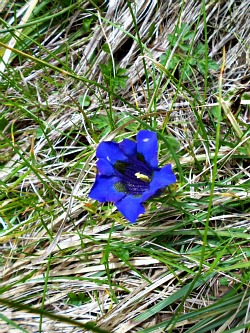
Alpine plants usually have long tap-roots that delve deep into the soil in search for moisture and nutrients. This is mainly because the erosion of mountain peaks and ridges creates steep piles of rubble known as scree, and the plants growing on these slopes have to cope with loose, shifting rocks and stones. Rain will also quickly drain such a habitat – so, long searching roots are necessary to the plants in order to both anchor themselves to the ground and find water.
All plants that grow in habitats above the tree line, therefore, can rightly be termed “true Alpines”; however, many of them also occur at lower levels, below the tree line, in the so-called sub-alpine zone (or even below).
Some people like to refer to these latter as mountain flora – or even “horticultural Alpines”, and while knowing these distinctions can be helpful, it can also be confusing – so, for the sake of clarity, I will consider them here as Alpines too.
Alpines have adapted to their harsh natural environment in various ways. The root system is one way, but it is invisible to the naked eye. Forming a low cushion or a spreading mat is another common strategy developed in order to resist high winds and desiccation – perhaps the most common – and it is also much more easily detectable at first sight.
The environmental factors then explain why most Alpines are low growing, with compressed or prostrate stems which allow them to survive buried under deep snow even for long periods of time without damage.
The genus Saxifraga makes for a good example of this adaptation strategy (in the first picture below, a selection of Saxifrages from the Alpine House in Wisley RHS Garden, England), but into this category other genera such as Minuartia, Sedum, Androsace – plus many Galium, Silene, Papaver, Primula and Gentiana species – should also be included (in the second image below, the low-spreading, mat-forming Minuartia sedioides, pictured in the Cansiglio Botanic Garden).
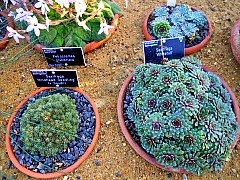
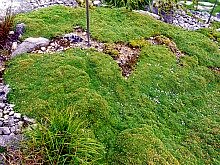
In such extreme conditions, plants may only be able to survive if they huddle close to the ground and take a rounded cushion shape.
This shape allows plants to expose the minimum surface area possible to hostile weather conditions, and thus present little resistance to the wind. Inside the cushion, the live stems often remain clothed with dead leaves from the previous growing seasons, so that the living parts are ‘insulated’ and therefore protected from the cold.
In fact, the rounded shape acts like a small micro-climate in its own right, giving the plant an ability to self-regulate. The cushion shape also creates a natural sponge, which makes the plant resistant to drought.
The formation of a tight cushion (or ‘bun’ shape) could in fact be seen as the quintessentially ‘Alpine’ feature, in that it is also the easiest to identify.
It is a typical adaptation for surviving in extreme conditions, and a cushion plant can quite rightly be called a ‘true’ Alpine, regardless of the genus to which it belongs.
These high mountain plants, which grow in such hostile habitats – such as cracks and crevices on sheer rock faces – are dormant for most of the winter, and then suddenly come to life in spring, when they receive a steady supply of water from the melting snow.
At that point they burst into bloom, often producing showy masses of tiny packed flowers. The higher the altitude, the more these mat- and tuft-forming species tend to be tighter and compact, huddling themselves to the ground.
These cliff-dwellers – or casmophytes, as they are termed in botanical jargon – can be seen clinging on to rock walls or narrow ledges by their deeply penetrating root systems, and are often tough and slow-growing, creeping along the ledges or nestling in cracks.
Another typical genus to develop such tightly-knit mats of small rosettes is the Sempervivum (Houseleek in English); in the first image below is Sempervivum arachnoideum, pictured again in the Alpine House at Wisley RHS Garden, England, while the second picture portrays Sempervivum tectorum in the setting of Cansiglio Botanic Garden.
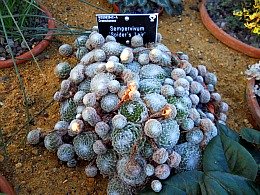
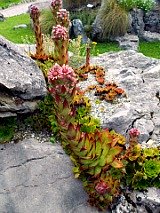
On the contrary, geophytes are plants that grow from a bulb, corm, rhizome or tuber. The term geophyte includes any plant that dies down to an underground storage organ for part of its life-cycle, such as many terrestrial orchids.
However, true Alpine habitats, with their short summers, have few bulbous plants; nevertheless, there are a few high-altitude bulbous species that are known as snow-melt plants, as they burst into life once the frozen ground thaws.
These include members of genera Crocus and Galanthus (the latter, incidentally, is known in Italian as bucaneve – literally, “snow-piercer” – precisely for that reason), but also less common species such as Dog’s Tooth Violet (Erythronium dens-canis, pictured below in the dry woods of Alpago) belong to this category.
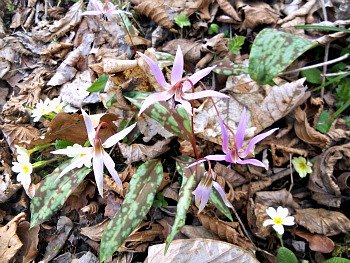
Geophytes are commonly referred to as bulbs – but as we have seen they also include corms, rhizomes and tubers.
From a botanical point of view, a true bulb is made up of swollen leaf bases, thus creating layers that are easily seen if the bulb is cut in half (as in an onion); these genera include Narcissus, Allium, Scilla and Muscari (below, a picture of Narcissus romieuxii, an early-flowering species of Daffodil in the Alpine House at Wisley RHS Garden, England).

A corm, found in plants such as those belonging to genus Crocus and Gladiolus, is a compact swollen stem, and it is solid rather than layered; unlike most bulbs, a corm is formed every year, as all the reserves are being used up when the plant begins to grow.
A tuber is a swollen part of a stem or root (such as in potatoes, or in genus Cyclamen), while a rhizome is a horizontal, branching underground stem (as in genus Iris).
Annual plants are rare in the Alpine zone, as there is not enough time for them to germinate, grow, flower and set seeds in the short growing season available, but biennials are a far more common sight.
These plants take two years to complete their life cycle – so being a biennial could rightly be seen as another adaptation strategy, developed in order to survive the harsh mountain environment.
I hope that this page has provided you with some basic information on Alpine flora: what Alpine plants are, where and how they grow, and how they look like.
But if you want to read more about it, you can also refer to Flowers-of-the-Dolomites – a page on which I have listed all my favourite flowers in the Dolomites.
Another page that you may find useful if you are in search of more ‘techincal’ information on Alpine flora is more specifically related to the Flora of Cansiglio.
There is also a page on the Flora of the Dolomiti Bellunesi, and a more general page dedicated to Alpine Botanic Gardens, from which you will be able to access further pages on the individual gardens.
In the final image below, the yellow blossoms of Primula auricula are seen growing on limestone rock in the area of the Vette Feltrine (Primula is a large genus, displaying great variety in colors and flowering times, and also in terms of habit of growth, as some of them behave like casmophytes – precisely like P. auricula).
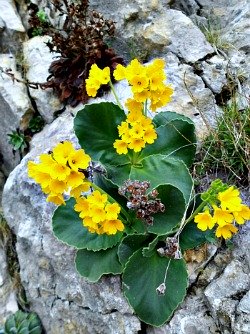
Return from Alpine Flora to Dolomites Flowers
Return from Alpine Flora to Italy-Tours-in-Nature
Copyright © 2013 Italy-Tours-in-Nature

New! Comments
Have your say about what you just read! Leave me a comment in the box below.